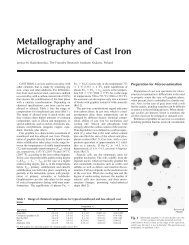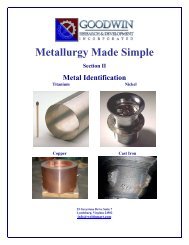Introduction Quantitative X-Ray Diffraction Methods Introduction ...
Introduction Quantitative X-Ray Diffraction Methods Introduction ...
Introduction Quantitative X-Ray Diffraction Methods Introduction ...
Create successful ePaper yourself
Turn your PDF publications into a flip-book with our unique Google optimized e-Paper software.
<strong>Introduction</strong> <strong>Quantitative</strong> X-<strong>Ray</strong> <strong>Diffraction</strong> <strong>Methods</strong><br />
(prepared by James R. Connolly, for EPS400-001, <strong>Introduction</strong> to X-<strong>Ray</strong> Powder <strong>Diffraction</strong>, Spring 2010)<br />
Constrained XRD Phase Analysis: If independent chemical or other information about the<br />
constituents in a sample is available, this information may be quantified and added to<br />
quantitative experimental data to constrain the results. The article by Snyder and Bish (in<br />
Bish and Post, 1989) discusses the general rationale for how to approach analysis with this<br />
type of complimentary data.<br />
Full-Pattern Analysis – the Rietveld Method<br />
Advances in computer technology have placed the computing power of the large mainframe<br />
systems of 30 years ago on virtually everyone’s desktop. The availability of this computing<br />
power (and the diligence of a lot of dedicated computer programmers) has enabled<br />
diffractionists to work with the whole XRD pattern instead of just the relative intensities of a<br />
few identified peaks. Whole-pattern analyses are predicated on the fact that the diffraction<br />
pattern is the sum total of all of the effects, both instrumental and specimen-related, that we<br />
have discussed earlier in our sections on “<strong>Diffraction</strong> Basics.” The basic approach is get the<br />
best data you can (with or without an internal standard), identify all the phases present and<br />
input basic structural data for all phases, then let the computer model your data until the best<br />
fit to the experimental pattern is obtained.<br />
The Rietveld method was originally conceived as a method of refining crystal structures<br />
using neutron powder diffraction data. The method requires knowledge of the approximate<br />
crystal structure of all phases of interest in the pattern. The quantity minimized in Rietveld<br />
refinements is the conventional least squares residual:<br />
R<br />
j<br />
w<br />
j<br />
(Material in this document is borrowed from many sources; all original material is ©2010 by James R. Connolly)<br />
(Revision date: 6-Apr-10) Page 10 of 14<br />
I<br />
where I j(o) and I j(c) are the intensity observed and calculated, respectively, at the jth step in the<br />
data, and w j is the weight. Detailed discussion of the Rietveld method is way beyond the<br />
scope of this brief introduction, but it is important to understand that this method, because<br />
of the whole-pattern fitting approach, is capable of much greater accuracy and precision<br />
in quantitative analysis than any peak-intensity based method.<br />
In Rietveld analysis, if an internal standard is used it is utilized to calibrate the scale factors<br />
used by the program to match the model and experimental data, not to compare with the<br />
phases being analyzed. A “normalized” fit can be performed without an internal standard,<br />
but as with Chung’s normalized RIR method, the refinement will not usually succeed if<br />
something is missing.<br />
Since the refinement “fits” itself to the data by modifying structure and instrument<br />
parameters iteratively, the Rietveld method holds several advantages over other peak<br />
intensity-based methods:<br />
j(<br />
o)<br />
Differences between the experimental standard and the phase in the unknown are<br />
minimized. Compositionally variable phases are varied and fit by the software.<br />
I<br />
j(<br />
c)<br />
Pure-phase standards are not required for the analysis.<br />
Overlapped lines and patterns may be used successfully.<br />
Lattice parameters for each phase are automatically produced, allowing for the<br />
evaluation of solid solution effects in the phase.<br />
2








